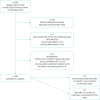Lung function improvement on triple modulators: high-resolution, nationwide data from the Danish Cystic Fibrosis Cohort
- PMID: 39655171
- PMCID: PMC11626609
- DOI: 10.1183/23120541.00339-2024
Lung function improvement on triple modulators: high-resolution, nationwide data from the Danish Cystic Fibrosis Cohort
Abstract
Background: People living with cystic fibrosis in Denmark had early, universal access to triple modulator treatment with elexacaftor/tezacaftor/ivacaftor. Close monitoring allowed us to assess the impact of treatment on lung function and progression of lung disease in an unselected nationwide cystic fibrosis population from 6 years of age.
Methods: Data were analysed using linear mixed-effect models to assess changes in levels and annual rates of change (slopes) in percent predicted (pp) forced expiratory volume in 1 s (FEV1), forced vital capacity (FVC) and forced expiratory flow at 25-75% of FVC (ppFEF25-75%) between the 12 months pre-treatment and treatment periods. Subgroup analyses assessed the impact of elexacaftor/tezacaftor/ivacaftor among those with/without previous modulator treatment, normal/mild/moderate/severe lung disease at treatment initiation, children/adults and birth cohorts.
Results: We included 392 people living with cystic fibrosis with a median (interquartile range) 12 (nine to 15) spirometry measurements per person. The mean (95% CI) improvement in ppFEV1 was 13.0 (11.3-14.6) 12 months after initiation of elexacaftor/tezacaftor/ivacaftor treatment. The annual rate of change improved from -1.4 (-2.1 - -0.6) ppFEV1 in the pre-treatment year to 2.7 (1.8-3.5) ppFEV1 per year during treatment. Similarly, ppFVC increased by 8.0 (7.1-8.9) and FEF25--75% by 19.5 (17.0-21.9).
Conclusions: Using high-resolution data from a nationwide real-world setting, our study documents the impact of elexacaftor/tezacaftor/ivacaftor on lung function across subgroups based on age, disease severity and treatment history. These findings point towards a new period of consistent lung function improvement among people living with cystic fibrosis on elexacaftor/tezacaftor/ivacaftor.
Copyright ©The authors 2024.
Conflict of interest statement
Conflict of interest: T. Qvist reports receiving payment for lectures, presentations, speakers’ bureaus, manuscript writing or educational events from Vertex Pharmaceuticals in 2021–2024, outside the submitted work. Conflict of interest: S. Jensen-Fangel reports receiving payment for a lecture on pulmonary infections in the immunocompromised host from GSK, outside the submitted work; and participation on a 2023 advisory board for Takeda, outside the submitted work. Conflict of interest: The remaining authors have nothing to disclose.
Figures


References
-
- European Cystic Fibrosis Society (ECFS) Patient Registry . Annual Report 2022. www.ecfs.eu/projects/ecfs-patient-registry/annual-reports. Date last accessed: 30 October 2022.
LinkOut - more resources
Full Text Sources
Miscellaneous
